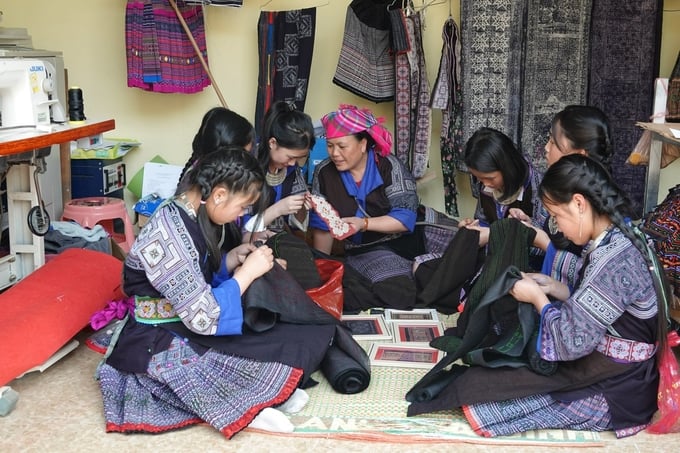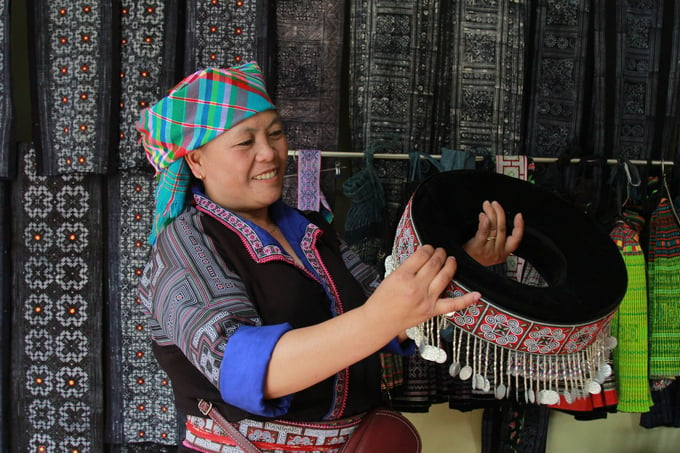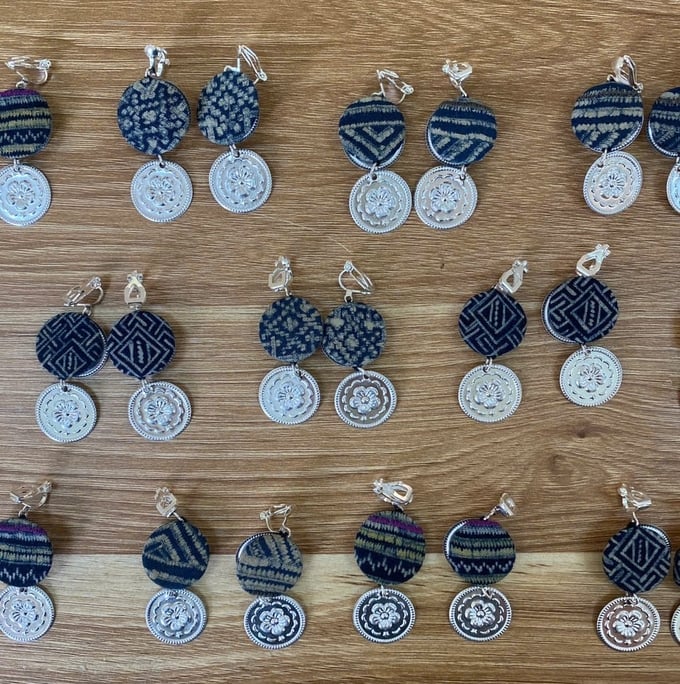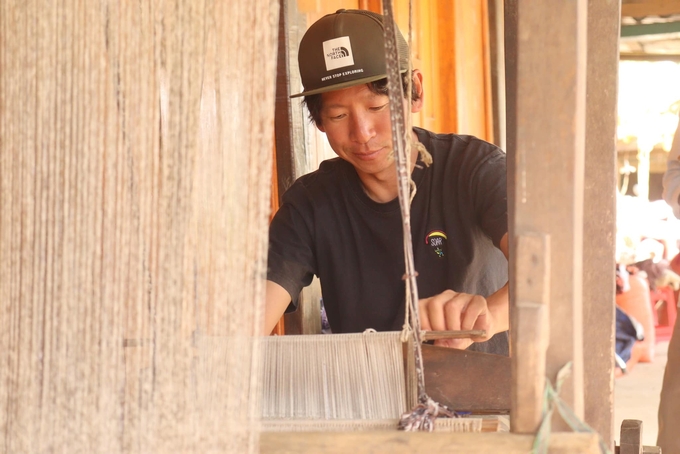November 27, 2025 | 15:31 GMT +7
November 27, 2025 | 15:31 GMT +7
Hotline: 0913.378.918
November 27, 2025 | 15:31 GMT +7
Hotline: 0913.378.918
In recent years, tourism in Mu Cang Chai has seen remarkable growth, unlocking potential and making it one of the most attractive destinations in the Northwest region. Known not only for its magnificent mountains, mysterious forests, and surreal terraced fields that captivate visitors, this land also boasts a rich cultural heritage and unique ethnic identities for travelers to experience and explore.

Hmong women before getting married have to make their own custom. Photo: Thanh Tien.
For generations, when the rice harvest is safely stored and the corn from the mountains has been brought home, the Hmong women begin sewing skirts and embroidering patterns. Every Hmong woman, once she reaches adulthood, knows how to spin and weave fabric to serve the daily needs of her family. When she marries, each girl must sew her own skirt to wear on her wedding day. Spinning and weaving also showcase her skill and diligence, which are considered measures of her talent and virtue.
In recent years, tourism has thrived in Mu Cang Chai, and many women have started creating products to sell to tourists, both to increase their income and to promote their ethnic culture. The Che Cu Nha brocade weaving Cooperative was established in 2018 with 23 members, serving as both a production center and a place to revive and promote traditional cultural values, where visitors can experience the art of brocade weaving. Here, artisans craft handmade brocade items like skirts, bags, blankets, and decorative pieces, each adorned with the rich cultural patterns and vibrant colors of the Hmong.

Ms. Ly Thi Ninh is hoping to establish a brocade weaving Cooperative in Mu Cang Chai. Photo: Thanh Tien.
Ms. Ly Thi Ninh, the head of the Che Cu Nha brocade weaving Cooperative, shared that most members brought materials home to work on. Creating unique garments involves many steps and requires the meticulous, skillful hands of the artisans from growing flax and spinning threads to wax printing, indigo dyeing, and embroidery.
Each March and April, the local Hmong people begin planting flax, which they harvest in August and September. After drying the flax fibers in the sun, they strip them into threads, which are then pounded, rolled into balls, boiled repeatedly until softened and whitened, sun-dried, divided into threads, and finally woven into fabric.
Completing a full outfit requires considerable time. If done consistently, it takes three to four months, but if done in spare moments during the agricultural off-season, it can take up to a year. These new garments are worn during significant occasions, such as weddings, the New Year, and festival seasons.

A Chinese visitor is trying painting on fabric. Photo: Thanh Tien.
Currently, the cooperative is located in a spacious area in Mu Cang Chai, near the iconic terraced rice fields, making it accessible for both domestic and international tourists who come to visit, experience, and shop at the stalls.
Many international tourists spend an entire afternoon exploring the weaving process, actively participating in steps like weaving and wax-painting on fabric. Afterward, they can wash and embroider designs onto their pieces, creating unique keepsakes.
Japanese volunteer Ms. Takada Yuka, who has been assisting the local people in tourism development for a year, appreciates the activities of the Che Cu Nha brocade weaving Cooperative. Over the past year, she has introduced about 80 Japanese visitors to the cooperative, where they thoroughly enjoy the cultural experience of traditional weaving by Hmong women.

Souvenirs are loved by many foreign visitors. Photo: Thanh Tien.
Previously, the women focused on weaving fabrics and embroidering clothing, which was high-value work, with each outfit priced between VND 2-3 million, and the most elaborate ones selling for tens of millions. Most tourists would rent the outfits for photos rather than buying them. Ms. Yuka has since suggested and guided the women in creating smaller items like earrings, hair ties, pillows, keychains, brocade paintings, and souvenirs. Many tourists have taken a liking to these items, purchasing them as mementos or gifts, helping the cooperative diversify its offerings and increase its income.
Japanese tourist Mr. Hiroki shared, “This is my first time visiting Vietnam through Ms. Yuka’s recommendation, and the scenery here is magnificent, with friendly people. Their work is meticulous and elaborate without trying it yourself, you can’t imagine the effort behind the colorful, intricate skirts they create.”

Mr. Hiroki is experiencing wax-painting. Photo: Thanh Tien. Photo: Thanh Tien.
“These small souvenirs are truly beautiful; seeing the girls work by hand really shows how intricate it is. I bought a few brocade earrings to bring back as gifts for my family”, Ms. Hong Hong shared.
In 2024, Ms. Ninh’s cooperative is receiving support from local authorities to transition into an official cooperative aimed at expanding production and creating more professional textile products, promoting, and finding better markets for these cultural items.
In addition, the cooperative will focus on training the younger generation, helping preserve and develop the craft of brocade weaving, and creating income for many households in the community.

Ms. Hong Hong, a Chinese tourist, is interested in the painting of Hmong women. Photo: Thanh Tien.
The ultimate goal for these women is for the cooperative to be both a production space and a cultural preservation center. Brocade products are not just clothing but also carry the history, customs, and lifestyle of the Hmong people, bringing cultural value to both the local community and visitors from around the world.
Translated by Kieu Chi

(VAN) On the morning of November 27 in Beijing, Minister Tran Duc Thang and the Deputy Commissioner General of the General Administration of Customs of China signed a protocol on fresh jackfruit exports.

(VAN) As floodwaters recede, a vast network of irrigation works across eastern Gia Lai is emerging in a state of severe disrepair, with extensive damage demanding urgent restoration ahead of the 2025-2026 winter-spring cropping season.

(VAN) The conference reviewing three years of implementing Decision 911 identified the need to prioritize improving marine environmental quality and promoting sustainable fisheries development.

(VAN) Le Hoai Trung, Member of the Communist Party of Viet Nam Central Committee and Minister of Foreign Affairs, held talks with Vi Thao, Chairman of the Guangxi Zhuang Autonomous Region (China) this week.

(VAN) The Mekong River Commission adopts the 2026 - 2030 Strategic Plan with a people-centered approach.
/2025/11/26/1720-1-200855_132.jpg)
(VAN) Viet Nam and Japan have many conditions to expand cooperation on climate change adaptation, particularly in disaster risk management based on advanced technologies.

(VAN) The strong development of digital technology and artificial intelligence is opening up opportunities to transform science and technology into a 'Magic eye' for disaster forecasting and early warning.